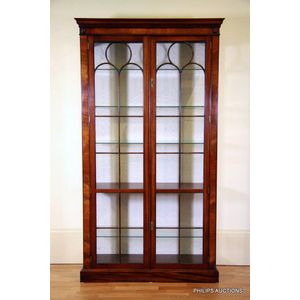Antique Breakfront Bookcase with Glazed Panels
You must be a subscriber, and be logged in to view price and dealer details.
Subscribe Now to view actual auction price for this item
When you subscribe, you have the option of setting the currency in which to display prices to $Au, $US, $NZ or Stg.
- Dentil Moulding - An architectural ornamental feature found on furniture, usually directly beneath the upper mouldings on a cornice. The timber is cut in a series of deep rectangular sections, alternatively raised and flat, like the crenellation on a castle battlement. In appearance not unlike a row of small teeth. From the latin "dens", teeth. Most commonly seen on bookcases, chests and cabinets, and less frequently on desks and wardrobes.
- Bevel / Chamfer - In furniture making, a chamfered corner refers to a technique used to create a smooth, angled edge on the corner of a piece of furniture. This is typically done by cutting away a small portion of the corner at an angle, typically 45 degrees, creating a diagonal edge, rather than a sharp 90-degree angle. This technique can be used on various parts of a piece of furniture such as table legs, drawer fronts, or door frames. Chamfering can add visual interest to a piece and can help to soften the overall look of a piece of furniture. It is often used in conjunction with other techniques, such as rounding edges or using contrasting wood species to create a more elegant, sophisticated look. Chamfering is a simple way to add a touch of elegance to a piece of furniture and it is a common technique used by furniture makers.
- Breakfront - A design generally found in larger pieces of furniture, such as bookcases, wardrobes and some sideboards. The line of the front is interrupted by the middle section standing out from each end. In a reverse breakfront, the centre section is recessed behind each end. Breakfronted pieces are usually made in three sections the middle and the two wings which are held together by the cornice and pediment, and the plinth on which it stands. The sensible buyer should show caution before buying breakfront pieces, especially bookcases, which are highly desirable and expensive. Always check that the timber, colour, patination, backboards, decoration and thickness of the wood are same in each section.
- Plinth - The square or rectangular base of a piece of cabinet furniture, often ornamented with moulding. The plinth may be separate, as in some wardrobes or presses, and act as the support for the carcase. In a false plinth, the moulded boards may be attached directly to the piece. Furniture with a plinth base usually does not have separate feet. The term derives from architecture where it denotes the base of a column or statue.
- Panels - Timber pieces, usually of well-figured wood either recessed or applied over the frames of doors and as decoration elsewhere in the carcase of cabinet furniture. The panels may take a variety of shapes rectangular, square, shield shape, oval, half-round or in the form of Egyptian pylons.
- Frieze - An architectural term denoting the flat, shaped or convex horizontal surface of furniture, between the architrave and the cornice, usually found on a cabinet or bookcase, or on desks and tables where it may include drawers, the area between the top and the legs. In ceramics, the term refers to the banding, of usually a repeating pattern, on the rims of plates and vases.
This item has been included into following indexes:
- bookcases, function or type
Visually similar items

An impressive Victorian walnut four door dwarf bookcase. 114 cm high, 164 cm wide, 49 cm deep.

A two door mahogany display cabinet, 20th century, an elegant tall cabinet glazed to three sides, having an extended cornice with simple target medallion details, full length astragal glazed doors and internal shelving, fitted with lights, height 201 cm wi

An Art Deco mahogany bookcase display cabinet, circa 1920s-30s, the elegant cabinet with arching glazed doors with palisander detailing and a conforming arched top flanked by slender pillar form breakfront cupboards with feather banded veneer doors opening

Art deco longcase grandfather clock, with weight driven Westminster chimes striking movement, 187 cm high
